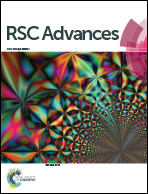A methanol and protic ionic liquid Ugi multicomponent reaction path to cytotoxic α-phenylacetamido amides†
Abstract
The Ugi four component reaction of an aldehyde, amine, isocyanide and an ethanoic acid was effected smoothly in protic ionic liquids ethylammonium nitrate (EAN) and propylammonium nitrate (PAN) to afford analogues of α-phenylacetamido amides in good to excellent isolated yields. The corresponding reactions in [BMIM][PF6] and the protic ionic liquid ethanolammonium nitrate (ETAN) failed. Microwave irradiation in EAN facilitated rapid access to three focused libraries, based on the parent isocyanide: cyclohexyl isocyanide, benzyl isocyanide and ethyl isocyanoacetate. Analysis of the structure activity relationship data suggested the presence of a bulky moiety originating from the isocyanide (cyclohexyl and benzyl) enhanced cytotoxicity. Removal of the acetylenic H-atom from the ethanoic acid moiety was detrimental to cytotoxicity. The most active analogues produced, N-(2-cyclohexylamino)-1-(4-methoxyphenyl)-2-oxoethyl-N-(3,5-dimethoxyphenyl)propiolamide, returned average GI50 values of ≤1 μM across the cancer cell lines evaluated. Combined, these data suggest that analogues of this nature are interesting potential anti-cancer development leads.



 Please wait while we load your content...
Please wait while we load your content...